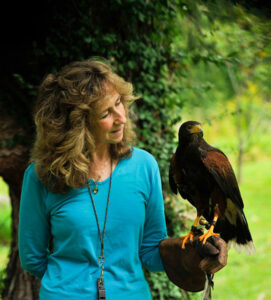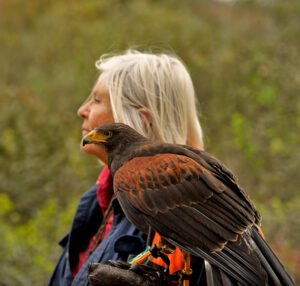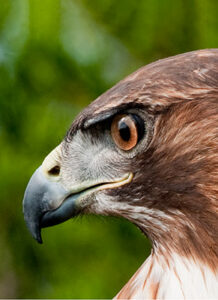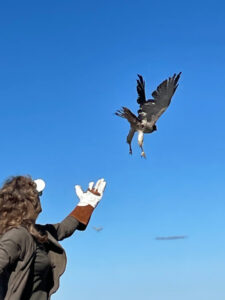THE HAWK’S WAY: ENCOUNTERS WITH FIERCE BEAUTY
By Sy Montgomery
Atria Books (May 3, 2022), 9781668001967
Inches from my face, I hold a living dinosaur.
Like his ancestors, the creature I hold on my fist is a hunter, an eater of meat. As did his forebears, the therapod dinosaurs—creatures like Allosaurus, Velociraptor, Tyrannosaurus—this bipedal predator possesses large finger bones and forward-facing eyes bestowing excellent binocular vision. Like them, when he hatched out of the egg, he was covered with down. As with many of them, his baby down then gave way to feathers.
The difference is, unlike the other dinosaurs, the one before me can fly.

Mahood and I are meeting for the first time. He has not yet learned how to hunt. Henry is trying to teach him. Henry wants Mahood to get used to being around people, which is why he’s asked me to bring my falconry glove and come over.
Mahood consents to perch on my glove. But the next moment, without any warning, he turns his head, looks into my eyes, opens his yellow, razor-sharp beak, and screams, full force, into my face.
Mahood does not like me, and is not shy about announcing this. His is not a scream of fear, but of fury: the voice of an angry dinosaur. All birds, we now know from fossils and DNA, are, in fact, what became of the reptiles who once ruled the earth, creatures we all used to think were extinct. That they are not is a truth that Darwin’s champion, Thomas Huxley, suspected as early as 1867; he called birds “glorified reptiles.” But the connection between birds and dinosaurs is impossible to miss in a raptor.
My husband, watching from a comfortable distance, is alarmed by Mahood’s scream. He’s used to seeing strange dogs and cats, pigs and chickens, horses, and even an octopus, relax to my touch. But I am not surprised at all by Mahood’s reaction. Hawks, as I now know well, are different.

Sometimes a hawk you’ve worked with for months or even years will attack. Henry’s previous hawk, a big female redtail, Mary, one day flew out of a tree and, instead of landing on his glove, strafed his ear, slicing through the cartilage with her outstretched talons. The upper part of his ear flopped over like a Labrador’s. (Emergency room doctors braced it so it would heal upright again.) Why? We never knew. (My husband sent me out with a hard hat the next time I flew her with Henry—but I left it behind, because many hawks dislike hats and scream at you till you take it off.)
Hawks do not play by our rules. You can never assume that a hawk, even one you raised from a chick, will forgive your mistakes—sometimes a single error ruptures the relationship forever. A hawk will not come to your rescue if you’re in trouble. A hawk will not comfort you if you are sad. What a falconry hawk will do, if you do everything right, is allow you to be their hunting partner—”the junior partner,” Nancy is quick to point out, for the hawk, with its exquisite vision and lightening responses, is always the superior hunter.
“It’s a funny kind of relationship you have with a hawk,” Henry tells me weeks later. We are walking through the forest, and Mahood is keeping pace with us, flying overhead, then perching on tree limbs, looking down and keeping track of us below, what falconers call “following on.” Mahood is still immature, and Henry is well aware of the responsibility he bears for nurturing this young soul. But what is the nature of the bond you can share with a raptor?
“It’s confusing,” says Henry. “It’s love, but all mixed up with nerves and hunger and the hunt. Human love trying to keep up with superhuman things. It’s not like any other relationship you have with anyone else.”
 If you do everything right, a hawk will allow you to act as its servant. And for this, the falconer is profoundly grateful.
If you do everything right, a hawk will allow you to act as its servant. And for this, the falconer is profoundly grateful.
The birds of prey preserve an ancient, primal wildness, conserved in their kind since the beginning of the world. And it’s exactly for this reason that, more than a decade after my first experiences with falconry, which I will share in the following pages, I still come back for more. I am still learning.
Today, the birds I first flew with Nancy are gone, but I have come to know their successors, and enjoy flying them with her. I’m thrilled Mahood is living on our street and plan to join Henry flying him often. And I am always looking overhead for raptors, listening for the wild and savage sound of their voices.
I am drawn, and expect I ever will be, to the company of hawks—to be bathed, like a baptism, in the presence of their fierce, wild glory.
Just like friendships with different people, relationships with individuals of other species have lessons to teach us. We are, of course, deeply enriched simply by learning about lifeways other than our own: I love it that some creatures I’ve been privileged to know can taste with their skin (octopuses), see with sound (dolphins and bats), and perceive colors we can’t even imagine (birds and some reptiles). But animals also have much to show us about how we, as humans, can more meaningfully and compassionately encounter the wider world.
Our fellow animals teach us lessons about the delights of sameness and differences. They immerse us in wonder. They lead us to humility; they inspire us to reverence. They teach us the many facets of love.
The ancient Greeks said there were four kinds of love. Eros was named after the dangerous and powerful God of Desire, whose Roman counterpart was the mischievous Cupid. Eros described what we now, in the West, call romantic love. Storge is a very different kind of love: the instinctual affection of a parent towards its offspring and vice versa. Philia names the love shared by friends and equals, and gives us words such as philanthropy.
The highest form of love was called Agape. This is a love untainted by expectations, a love without external reward. The other kinds of love, though celebrated and essential, are transactional. Eros yearns for sexual fulfillment. Philia’s bonds are forged by mutual friendship and trust. Storge is run by selfish genes. But unlike these, Agape is selfless, pure, and unconditional. In the Bible, Agape came to stand for the love God has for His Creation, and the love humans should endeavor to feel toward the Creator in worship. But in the way of humans, we too often make even worship transactional: giving our allegiance in exchange for eternal life, or the promise of consorting, after a glorious death, with 72 heavenly virgins. (“Oh Lord/ Won’t You buy me/A Mercedes Benz?”) This is not true to the spirit of Agape: Unlike all the other kinds of love, agape asks nothing in return.
This is what a hawk can teach you: how to love like a god.
Once again, on a recent September afternoon, I am holding a dinosaur. It’s a blue-sky day, a light wind to the northwest, and the temperature has risen from the morning’s 50 degrees F to 65. Perfect. With 75 other people, I am at Miller State Park in Peterborough, NH, standing on top of Pack Monadnock mountain during one of the peak weeks of the hawk migration.
My husband and I often come up here on fall days to join other hawk watchers hoping to catch a glimpse of the spectacle overhead. From September to December, nearly 20,000 raptors of 15 species will pass over the mountain—often in groups ranging from handfuls to hundreds called kettles, swirling and spiraling upward on rising columns of warm air —on their way to southern wintering grounds. Volunteers and Hawk Watch staff from our local Audubon Society and the Harris Center for Conservation Education tally the birds’ numbers.
But today is extra-special. As part of a once-a-year tradition, a crowd gathers to watch the release of hawks who had been found sick or injured this past summer—birds who, thanks to the expert care of Deering, N.H. wildlife rehabilitator Maria Colby, are now healthy and whole, and ready to join the migration.
My friend Julie Brown, Hawk Migration Association of North America’s Monitoring Site Coordinator is here, as usual. But to my surprise, she has pulled a young broad-wing hawk from Maria’s transport carrier, and has handed the bird to me.
The broad-wing is a smallish, stocky, forest-dwelling raptor with chocolate streaks running across a light breast, and black and white bands on the tail. I often hear this species calling when one passes overhead, a distinctive, drawn-out, one-note whistle; but I have never before held one, or seen one this close.
Julie tells me to hold the bird in a manner completely unlike anything I’ve done in falconry. The bird doesn’t perch on my glove; instead I hold firmly onto the yellow legs and feet with one, leather-gloved hand, while using my other, ungloved hand to keep the wings from beating. Julie instructs me to hang onto the bird like this in order to display it to the admiring crowd before I let it go.
The hawk is understandably furious at this indignity. The broad-wing swivels its neck to stare into my face. To the bird, I am a monstrosity, its captor, its evil enemy. With fearless fury, the hawk lets loose a scream that feels like, with the help of a tiny spark, it could ignite a fireball and consume me, the crowd, the entire mountain. I am a 120-pound monster holding this one-pound creature in my hand. I am a heavy beast made of flesh and fluid; the bird I hold is made mostly of air, whose feathers outweigh its skeleton. Yet I stand deeply humbled by the power of its courage as it screams at me in fiery defiance.
So consumed am I with the broad-wing’s incandescent presence that I do not realize that the person who rescued the bird, Nancy Delaney, is in the crowd today. Weeks later, I have the pleasure of meeting her. Nan is a horsewoman, about my age, with short auburn hair and brown eyes. She has always loved animals. But she has never had anything to do with hawks.
On a rainy Saturday in July, she got a phone call from a friend. He had been hiking a trail near her home in Hollis, NH. He had spotted the hawk, looking drenched and obviously sick or injured, perched in a tree. But what could he do? “He had nothing with him to help him rescue the bird,” she said—and besides, he was in a hurry. He was leaving on vacation the next day. Could Nan help?
“I was home,” she explains to me. “So I grabbed a cat crate, a towel, and a pair of gardening gloves.” She headed for the trail. In the parking lot, she met a girl near the trail head. “Did you see a hawk on your walk?” she asked her. “I’m going to get him.” The girl came along.
They hadn’t walked far when they found the soaking wet bird. “He’s locked onto a branch and he’s eight feet up in a tree,” Nan tells me. “There was no blood or feathers on the ground,” she says, “but I knew he was really sick. I knew I was his last chance.”
Nan is strong, fit and tough, but she is not eight feet tall. But she realized she could reach the bird if she stood on top of the cat carrier.
“I stood,” she continues, “and looked him straight in the eye.” He was cold, wet, and clearly weak. She had tried calling two other wildlife rehabilitators before she set out; she finally reached Maria, who told her what to do. She hesitantly threw the towel with her right hand onto the bird, as she’d been instructed. “And at that moment he came alive,” she tells me, “flapping his wings but not moving from his locked perch.” There was no time for Nan to be scared, she tells me: “I realized I had to do it—and right then!” With her left hand, protected only with a green gardening glove, Nan reached under the towel and plucked the hawk from the branch. She stepped off the cat crate with the bird in hand. Before she put the hawk inside the carrier, Nan asked the girl accompanying her to take a photo: the hawk’s feet and legs are covered with a towel; one wing is extended; the bird’s beak is open. Nancy looks radiant.
“It was a moment in my life I’ll never forget,” she tells me. “I did something I don’t normally do. I wanted to make this happen.”
She delivered the bird to Maria’s rehab center, Wings of the Dawn, that afternoon. The next day, she phoned to see if the bird were still alive. “She ate a grouse for dinner, and two blue jays for breakfast,” Maria reported. That made Nan happy, until Maria told her, “these birds eat till the moment of their death.”
Maria let her know the hawk was broad-wing, a youngster of indeterminate sex, and that it had been poisoned—probably having eaten prey that had been killed with toxins people unthinkingly set out to poison mice and rats. But under Maria’s care, the hawk recovered completely. Nan kept in touch, and when Maria told her of the release, scheduled for September 19, she vowed to join her there.
But on this day, I’m unaware of Nan’s bravery or any of the details of the dramatic rescue as I clutch the bird’s feet in one hand and cradle its wings with the other. I only know what the bird wants next. The Hawk Watch’s organizers would prefer I release the raptor so it would fly over the gathered crowd, for the best photo; it’s a small favor to ask of the bird, and a big reward for the people who support the counts and the research on birds of prey, especially when many species of raptors are declining alarmingly. But all I can feel is the bird’s desire, burning as if it were my own: it wants to fly in the opposite direction, the direction in which all the other birds are flying, off the mountain, heading south.

I cannot imagine I’ll ever see that bird again; even if I did, I wouldn’t know it. Certainly the bird has no reason to remember me, either. I don’t matter to the hawk.
But the hawk matters deeply to me, and to Nan.
For her, rescuing the hawk “has opened a door I couldn’t have pictured or planned. I look at it as symbolic in my life,” she told me.
The last time she encountered such a powerful animal symbol, she was at a friend’s camp. She had never seen a luna moth before—but suddenly, the huge, showy, pale green moths were everywhere. Moths and butterflies are widely understood as symbols of new life—transitioning as they do from worm-like caterpillars, to pupae encased in their coffin-like cocoons, to flamboyantly beautiful, winged wonders. It was a time when Nancy was leaving an unhealthy relationship. She took it as a sign of transformation to come.
And what might the hawk symbolize in her life? I asked Nan. She doesn’t know yet. “I think the meaning of the bird— or my energy to transition it back into this world, and not to death—is unfolding.”
Since the release, we’ve both, independently and regularly, checked a website maintained by the Hawk Mountain Sanctuary, which tracks the travels of seven broad-winged hawks outfitted with either satellite or cell phone telemetry transmitters. The broad-wings were captured and tagged in Connecticut, Ontario, Pennsylvania, and New Hampshire. We have been particularly interested in the progress of an adult female named Monadnock.
Though it’s tempting to imagine this is the bird we both briefly held, she is not; this one is an adult, not a youngster, and was captured and tagged on her breeding territory in nearby Dublin, NH in June. Ours did not have telemetry. But we can hope, and reasonably believe, that the bird we held may have been traveling in her company, along with thousands of others. Before Thanksgiving, we saw with delight that she had already reached Colombia in South America.

